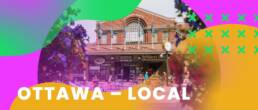Updated November 2022 | Photo credit: © Destination Ontario
Ottawa – Local
The nation’s capital is known for its impressive “big-ticket” possibilities: Parliament Hill, international festivals, nationally significant museums, and the world’s longest skating rink and largest Tulip Festival. But for millennia before French explorers arrived, Indigenous Peoples were living and trading in the region. Their history is everywhere, emerging more each day, and you can hear it in the language: the Algonquins called the region “Odawa”, where Ottawa’s name comes from, meaning “traders.” So, beyond those big-ticket possibilities, visit for a rich cultural experience, a palette of diverse cuisine, and creativity from all corners of the nation’s capital.
Day One
MORNINGTWO FARMS, TWO WAYS: THE EXPERIMENTAL FARM AND MĀDAHÒKÌ FARMS
INDIGENOUS PERSPECTIVES, INDUSTRY AND SPIRIT HORSES
Mādahòkì Farm builds on the growing interest in agritourism in Ottawa’s Greenbelt, including farm-to-table culinary experiences and authentic cultural experiences from an Indigenous perspective. The Farm hosts a series of Indigenous events celebrating the seasons: Sīgwan (Spring), Tagwàgi (Autumn) and Pibòn (Winter) and the annual Summer Solstice Indigenous Festival. Year-round, the Farm is also the home of an Indigenous Marketplace and five endangered Ojibwe Spirit Horses.
A WALK ON A WORKING FARM… IN THE CITY
In our changing industrial world, farms and cities are trying to strike a new balance with each other. The Central Experimental Farm is a few kilometres from downtown. But it’s no hobby farm, not at 426 hectares. Established in 1886, the farm has made significant contributions to Canadian agriculture, like developing the world-famous, frost-resistant Marquis wheat. When you visit, deep dive into our nation’s agricultural heritage at the Canadian Agricultural and Food Museum. Or, just talk to the animals: the museum is home to cows, alpacas, pigs, horses, goats and more.
At the Experimental Farm, wend your way along winding paths reminiscent of a British country estate: swathes of lawn, ornamental gardens, an arboretum with some trees planted back in 1889. Along the path, catch the distinctly Canadian sight of the Rideau Canal and Dow’s Lake. An Experimental Farm visit is a unique experience, literally: it’s the world’s only working farm in the heart of a capital city.
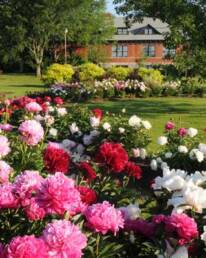
AFTERNOONHAPPENING HINTONBURG
QUIRKY AND CUTE: WELLINGTON WEST’S HINTONBURG
Bustling, artsy, trendy, eclectic, cool: just some of the descriptors of Wellington West, on your drive back in from the farms. East of Holland Avenue, it’s Hintonburg, with great specialty stores — a far cry from the rail yards, lumber and paper mills of its 19th century days. Same with the neighborhood’s designation as the QUAD (Quartier des artistes/Arts District), as Hintonburg is home to galleries, studios, and art-friendly restaurants.
As to those specialty stores: they are thinking local and sustainable. Terra20 sells cruelty-free, non-toxic and ethically sourced products. At Nu Grocery, Ottawa’s first zero-waste grocery store, you’ll find everything from cereals to toothpaste. Drop by the Maker House Co. for handmade homewares created by Ottawa artisans. Don’t forget music: The Record Centre, purveyors of new and used vinyl (and turntables), has also been known for local band performances.
Need a sip and snack break? Try one of the wonderfully named local chains: the Ministry of Coffee and Social Affairs, or Happy Goat Coffee.
AFTERNOONFASHION AND FOOD
GO WEST TO WELLINGTON VILLAGE
Go west (of Holland Ave.) to Wellington Village for a myriad of possibilities from Canadian independent designers. It’s all about boutiques. Kindred Shop and Studio’s ethically made clothing and made-in-Ottawa gifts; Flock’s handmade, local, sustainable wares; JV Studios & Boutique’s emerging Ottawa brands; Victoire Boutique’s “smitten with Canadian design” approach and more. For a break from shopping, head to the NAK Gallery, opened in 2020 to showcase contemporary visual art.
The Village is also a great spot for a leisurely dinner, with its nearly two dozen restaurants. Just a few possibilities include contemporary Canadian cuisine at Stofa; locally sourced fare at Supply and Demand; or upscale pub food at Wellington Gastropub. (Locals call it The Wellie.) Speaking of pubs, Ottawa craft beer is a growing concern. If it’s of concern to you, consider a Brew Donkey “curated regional adult field trip” to local breweries.
For a quick bite, try Beandigen Cafe, an Anishinaabe owned and operated cafe on the unceded territory of the Algonquin Anishinaabe. Located in the heart of the city at Ottawa’s Lansdowne Park, the café offers coffee, espresso, and light snacks as well as retail space to connect and purchase Indigenous goods, art and crafts from local Indigenous artists. Beandigen is a play on words from the term “welcome” in Anishinaabemowin (Ojibway), which inspired the name and feel of the cafe.”
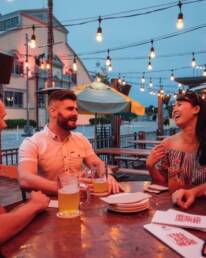
EVENINGTAKE IN A SHOW
IT’S GREAT, IT’S CANADIAN, IT’S THEATRE
The Great Canadian Theatre Company, or GCTC, as Ottawans call it, is located almost in the centre of Wellington West. It’s also at the centre of the local theatre scene. The city’s largest professional, independent theatre was born in 1975 when Carleton University profs and grad students decided to produce Canadian plays. After two decades of treading the boards in a renovated truck garage the GCTC moved to Wellington West. Now they showcase plays and theatre events at the Irving Greenberg Theatre Centre, with its 262-seat mainstage space. Bonus: Spacious lobbies and a studio theatre make GCTC a hub for community events.
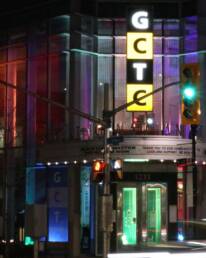
Day Two
MORNINGA NEIGHBOURHOOD WANDER
STROLL THE STREETS OF HISTORIC SANDY HILL
The sandy soil of this slightly-off-the-beaten-track residential neighborhood means you won’t see many tall buildings. But you will see dignified embassies and gracious apartment buildings (circa 1860 to the 1920s). Two of Canada’s most important prime ministers (Sir Wilfrid Laurier and the Rt. Hon. William Lyon Mackenzie King) lived in Sandy Hill. At some times of year you can visit their former home of Laurier House, a Second Empire mansion. Today, Sandy Hill is where affluence meets student living, with bars, brewpubs and coffee shops around the U. of O. Students, locals and tourists alike can enjoy cuisine from around the world, including India, Thailand, Mexico, Japan and Middle East. For a river walk, stroll Strathcona park along the Rideau, where in summertime you can enjoy theatre under the stars.
AFTERNOONSAW GALLERY
VISIT ONE OF CANADA’S LEADING ARTIST-RUN CENTRES
Stop at the SAW Gallery on your way to the market. The artist-run centre is famed for politically and socially engaged artwork and performances. Lured by the North? Check out SAW’s recently opened Nordic Lab with the Annie Pootoogook Studio, named for the celebrated Inuit artist. Take in a community event (from screenings to concerts to artist talks) at Club SAW, complete with bar and state-of-the-art sound system.
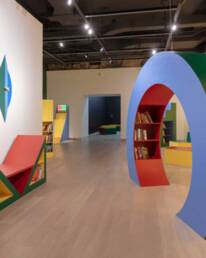
AFTERNOONGO TO MARKET
MAKE BYWARD MARKET YOUR ART WALK
ByWard Market is just a stone’s throw from SAW and a perfect place for a café lunch. Pick from a variety of cuisines, including Island Flava, Island Grill, Ocho Rios Caribbean Eatery, Sweetgrass Aboriginal Bistro. And, of course, for the sweet stuff, a.k.a. Beavertails. (Deep fried pastry and sugar. Say no more.) Lieutenant-Colonel John By drained a cedar bog and made a market here in 1827 so the families of workers building the Rideau Canal had a place to shop. Almost two centuries later the market still draws locals for great foodstuffs.
But it’s also a cultural draw. Follow the ByWard Market Art Walk map for stunning murals. The Art Walk includes murals by diverse artists, including Black and Indigenous muralists. Then drop by the Ottawa School of Art for contemporary art exhibits and to browse the boutique for paintings, jewelry and sculpture. All of it Canadian; much of it local.
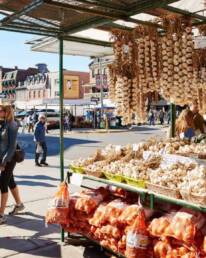
EVENINGBYWARD BY NIGHT
THE MARKET BY NIGHT: DRINKS, DINNER AND BEATS
There’s no shortage of nightlife in the market. Try the storied Chateau Lafayette, a.k.a. The Laff, Ottawa’s oldest tavern since 1849. Or go upscale with Copper Spirits and Sights Rooftop Lounge, for Canadian-inspired cuisine and craft cocktails. (It’s a great sunset spot with a prime view of Parliament Hill.) For late nights drop by the Mercury Lounge, the “twenty-first century soul club” where beats-meets-jazz. Come for drag shows, or to enjoy soca, rap, and rock music. The intimate Mercury has brought music, poetry readings and dance performances to Ottawans for over twenty years.
YOUR TRIP AT A GLANCE
YOUR TRIP AT A GLANCE
This guide represents a weekend-long experience, highlighting one of the many wonderful destinations in the area. To suggest a destination for a future guide, please contact us.
All editorial decisions were made at the sole discretion of Ontario Culture Days staff. This guide was written by Li Robbins.

